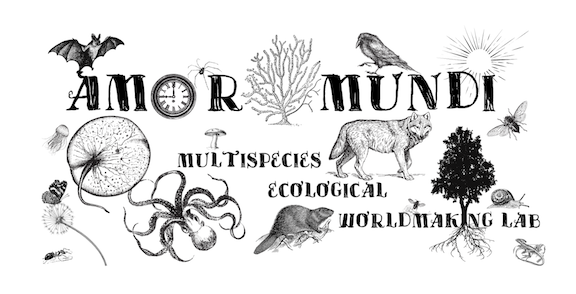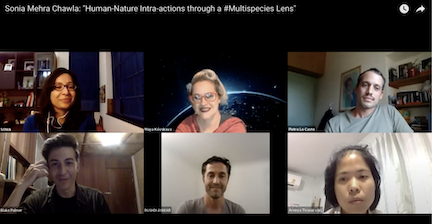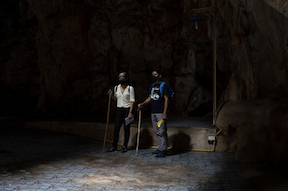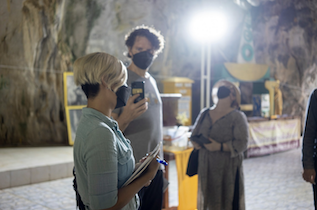The AMOR MUNDI Multispecies Ecological Worldmaking Lab transpires as a collaborative space for emerging scholars, artists, scientists, and practitioners of all kinds working in the Global South with a common theme in multispecies anthropocene studies. Anthropocene and ecopolitical theorist Maya Kóvskaya, who recently joined the Faculty of Social Science at Chiang Mai University in 2020, shares their idea of the lab and extends the opportunity to students across disciplines. Through Maya’s inspiring energy as the Lab Director, our network of collaborators and interlocutors grows. Among many who join and share their scholarship from around the world, a core group of people who are already based in Chiang Mai come together to give this emerging space a chance to move forward.

Version 2 logo of The AMOR MUNDI Multispecies Ecological Worldmaking Lab
One student named Areeya Tivasuradej, a master’s degree student in geography, was recently introduced to more-than-human geographies by her advisor, geographer Chaya Vaddhanaphuti. She finds its relationality and hybridity to be solemnly hopeful to understand the ongoing contradictions in modernizing Thailand while offering blurry ways to grope for possibilities with others that would not limit creativity. Although geographies in Thailand abound with more-than-human dimensions, the discipline itself has had limited engagement with ‘more-than-human’ theoretical approaches–just as limited as feminist geography. Anthropology, political science, and the humanities, however, are increasingly offering tools for understanding hybridity from posthuman perspectives. Not wanting to be limited by the division between physical and human geographies, Areeya engages with the AMOR MUNDI Lab to explore how colleagues in other disciplines ground these concepts and theories with local contexts while herself explores the more-than-human aspects of urbanity as she dug and weeded gardens with the Akha growers in Chiang Mai and mapped food (in)security as part of her master’s thesis.
Introducing Some of the Lab Members and Spaces for Meeting
Common interests among the Lab members bind us into a shared exploration of what more-than-human agency is and what it means when we take more-than-human agency seriously. Members of this core group come from diverse lived experiences and have many invaluable skills. Blake Palmer moved from the United States to pursue his dream as a writer and cultural critic working on popular culture and Asian contemporary art. He is now pursuing a master’s degree at CMU to research on multispecies biopolitics in the Southeast Asian context. Pietro Lo Casto is an Italian visual artist enrolled at the CMU Faculty of Fine Arts. He is interested in forests and rivers and histories of development and colonial pasts in Thailand. Myint Than is a former buddhist monk who is studying social sciences to seek various ways to enhance multispecies sustainability in Mon communities as Myanmar struggles in nation building. Anne Atchara Changwong is a plant-based chef who’s promoting mindful and environmentally conscious eating through fun and tasty fusion of tropical Latino, mediterranean Spanish and Thai culinary traditions.
Organizing a speaker series is one way to create space for introductions to new ideas and learning how to work together. In the 2021-22 academic year, seven headline speakers—and almost two dozen roundtable speakers—ranging from artists and anthropologists to environmental historians and geographers, accepted our invitations to give talks about their projects or recent publications as well as their experiences and tips under the theme of “Multispecies Worldmaking Possibilities in the More-Than-Human Anthropocene.”

Human-Nature Intra-actions through a #Multispecies Lens: An Art-Science Worldview By #multidisciplinary artist and researcher Sonia Mehra Chawla with AMOR MUNDI Lab’s Speaker Series
The speaker series kicked off with anthropologist Eben Kirksey in August 2021. Eben took us on a journey to explore the world of genetic engineering and CRISPR with his newest book, The Mutant Project. The talk was followed by a roundtable discussion with Maya, multispecies storyteller Ciclón Olivares, and cultural studies scholar Pasoot Lasuka (YouTube channel). The series brought together scholars, artists, and practitioners in a timezone that’s more accessible to Southeast Asia and nearby regions amidst the pandemic, during a time when many online talks and discussions are accessible, but in “global north” timezones. It’s also a chance for global south scholars to meet and exchange ideas with leading scholars in the field.
Everyone in the lab co-creates the learning space to familiarize with theories, terms, practices and doers in the multispecies network. Students, including Myint Than and Maya Dania, a PhD student and lecturer at Mae Fah Luang University (MFU), are encouraged to join roundtables as discussants and commentators with globally renowned scholars—a rare chance for many of us. Areeya and Blake help coordinate with speakers. Pietro manages social media. A special contribution for visual promotions was made by Indonesia scholar Reni Juwitasari at MFU. Anne nourishes this small community by providing plant-based catering to refuel our tired brains and shares her vast local knowledge of Thai and northern Thai cultures through her food.
Encountering Multispecies and Learning (Us) Together
Collaborations heightened when Eben Kirksey visited Thailand, and gave us an incredible chance to learn about multispecies ethnography and the arts of immersion with him. We followed Eben as he traverses the virosphere. Coronavirus lead us to a cave temple, Wat Tham Pla, in northern Thailand to think and speculate possibilities of the current predicament of modernizing Thailand amidst the pandemic. Our assignment was to observe the macaques who linger at the temple ground and their interactions with the environment and other species including humans and bats. As Areeya coordinated ground logistics, she spent time chatting with vendors who sold dog feed (for monkeys), noodles, grilled pork and fruits outside the temple and observing what they do to keep macaques away. Blake scanned spirit sculptures and materials that worshippers use to pay respect to Buddha and make fortune. Anne narrated everyday life objects to the group to explain what Thais believe and do when they come to the temple. Pietro’s fingers and eyes panned the camera for the stories of tensions and playful encounters that he heard during conversations with the abbot and others in the temple ground. Myint Than ascended to the dark Buddha and bat cave in the karst hill without a bamboo stick–an object designated as a protective tool for macaque-naive visitors like us. This was his approach to observe what macaques would do if he put himself in a risky and vulnerable position–and how he would respond. By seriously paying attention to these micro “intra-actions” (Barad 2007) specifically on what we do when we notice a macaque is present and what macaques do as we roam.
The ways we learn to notice the macaque landscape were also guided by the abbot’s rich stories of living with macaques and Buddhist teachings. Liveliness in his storytelling reflects his deep care and observations with macaques and offers ways to live together with other species. His stories become a guide for immersion. Immersion for us means learning to be attentive by doing what we’re observing and also observing what others are doing. We use various tools to record our multispecies encounters in a “multispecies contact zone.” Voice recordings of soundscapes and hand-written descriptions and field notes capture parts of what we see and hear at the field site. We take turns interviewing each other to help describe the scene and refine our interpretations with “response-ability” (Haraway 2016). Filming helps us to record the landscape and actions for future reference. As such, recordings are very useful to help us to see what we might not see or pay attention to in situ, especially with things we are accustomed to seeing in our everyday lives and non-representational things that words may not easily describe. Doing things together in the field is an important time and space to build rich and thick descriptions. It is also a good way for each of us to learn more about each other and everyone’s background and interests, while building collaborative solidarity.
Cooking and Multiplying Flavors of Collaboration
Our field notes become “raw materials” waiting to be sorted, prepared and “cooked.” Each person becomes a “chef.” Eben, the head chef, sweetens the bitter views on viral kin with happiness and luckiness as guiding conceptual frames to guide us through the process. Myint Than remixes our understanding of Buddhist teaching and reconnects with the abbot through discussions of dharma. Pietro takes an archivist role and manages a repository of writing and digital files to cook visual materials for us to re-think about the site. Areeya procures more secondary literature to contextualize our intra-actions. Anne spices up the dish by highlighting the abbot’s joyful storytelling. Eben and Blake shake up the drafts of our story while Maya works to ensure an overall coherence. Having no fixed structure, the process of writing and discussing together itself becomes the act of mixing our specialties and ingredients together to make one flavorful dish.
Sounds of bats, descriptions of bat poop smells, our uneasiness with the close proximity of the monkeys are described and compared to each other’s individual experiences and enable us and the audience to connect. We learn from one another about the things we might un-self-reflexively see as “normal” on our own, and thus fail to see its larger significance. Different perspectives on the same photo are shared to cross-check our understandings of the scene. Through a collaborative process, we are able to add life to written words as we describe the landscape and relations taking place in our research site.
Adding Thai speakers to the group allows us to link or contrast Thai concepts and terms with non-Thai vocabularies. Part of the cooking to reach the final dish, Anne – as the “food and culture critic” – explains the everyday experiences of going to temples or interacting with other Thais. Anne rechecks our academic understanding of Thai contemporary cultures and Buddhist practices. As the head chef, or lead author, Eben guides us all through the process and weaves together our stories with a thread to situate our final dish among ongoing debates on viral kin, before finishing it all with a touch of hope. “Symbiogenesis” and “Symbiopoiesis”—shared life-making and worldmaking practices—emerge in ways far stronger than what we could have done separately on our own. Our collaborations have guided us to co-author an article on viral coexistence and luck together.
Uncomfortable Moments in Collaborations
Awkward moments come when we need to decide the order of authors. In a collaborative project, we find it difficult to pinpoint the genealogy of ideas or take ownership of a particular idea. It might have been what Myint Than said while Areeya was thinking of the monkeys playing on the ground that encouraged Blake to think about biopolitics in a different way. Academia is still very hierarchical and over-determines the primacy of a zero-sum competitive paradigm putting individuals into needless competition rather than fruitful collaborations. For emerging scholars in Thailand, we are graded by the number of publications rather than the quality of our teaching and democratizing our knowledge. We are sure it’s similar elsewhere. It is not that we do not want to acknowledge the labor and time that each of us contribute to the project. But as Blake said, we need to find new ways to replace the competition in academia with non-hierarchical collaboration to truly cultivate transdisciplinary ways and collaborations with non-academic and emerging scholars at different stages of academia.
Despite our desire to produce collaborative works without needing to reduce our diverse and entangled contributions to a list of ranked importance, we have to acknowledge that most academic infrastructures are not yet set up to support more egalitarian approaches to authorship. For now, we must do what we can to ‘imagine otherwise’. We take care to acknowledge—to ourselves and others—the importance of our respective contributions and have made commitments to support each other in future efforts that ensure the benefits of our collaborations are shared equitably. Through such practices, we hope to help cultivate the type of academic landscape we would like to inhabit.
Little Hands in “Worldmaking”
The speaker series—including this year’s “Seeking Symbiopoiesis with the More-Than-Human Against the Anthropocene”—has been welcomed and supported by the Regional Center for Social Science and Sustainable Development (RCSD) at Faculty of Social Science and the Integrative Center for Humanities Innovation (ICHI) at Faculty of Humanities at CMU. Chayan Vaddhanaphuti, director of RCSD, has been a leading proponent of just co-production of knowledge. His strong belief in participatory knowledge-making processes opened up the opportunity for the lab to be a part of building the bridge between social sciences and humanities under the new transdisciplinary configurations such as the environmental humanities. This was a rare occasion at CMU for the two disciplines to collaborate officially at an institutional level. An intensive five-day workshop followed to bring emerging scholars in the global south together to explore transdisciplinary concepts and research practices.
Except for Maya, our core group here at CMU that we’ve just introduced above are still new to academic theoretical and hands-on research training. We have been working in other career paths for many years before meeting one another and joining the intellectual milieu of academia. We find multispecies ethnography open to diverse skills and experiences. As we learn to sense the more-than-human world, our diverse and non-unified training is helpful in bringing different perspectives and ontology to interpret the intra-actions we observe in the field. Through taking more-than-human agencies seriously, we also take part in building a community of learners to explore ideas and venture into new frontiers together.

Anne and Myint Than immerse themselves in the multispecies contact zone where bats, Buddhist prayers and tourists meet and might create possibilities for viral encounters. Pietro Lo Casto

Maya notices bats roosting in the cave where Buddhists come to pay respect to Buddha statues. Anne explains the everyday life practices of a buddhist in such a site as Eben records her descriptions. Photo Credit: Pietro Lo Casto
References
Barad, K. (2007). Meeting the Universe Halfway: Quantum Physics and the Entanglement of Matter and Meaning. Durham: Duke University Press.
Haraway, D. J. (2016). Staying with the trouble: Making kin in the Chthulucene. Durham: Duke University Press.
